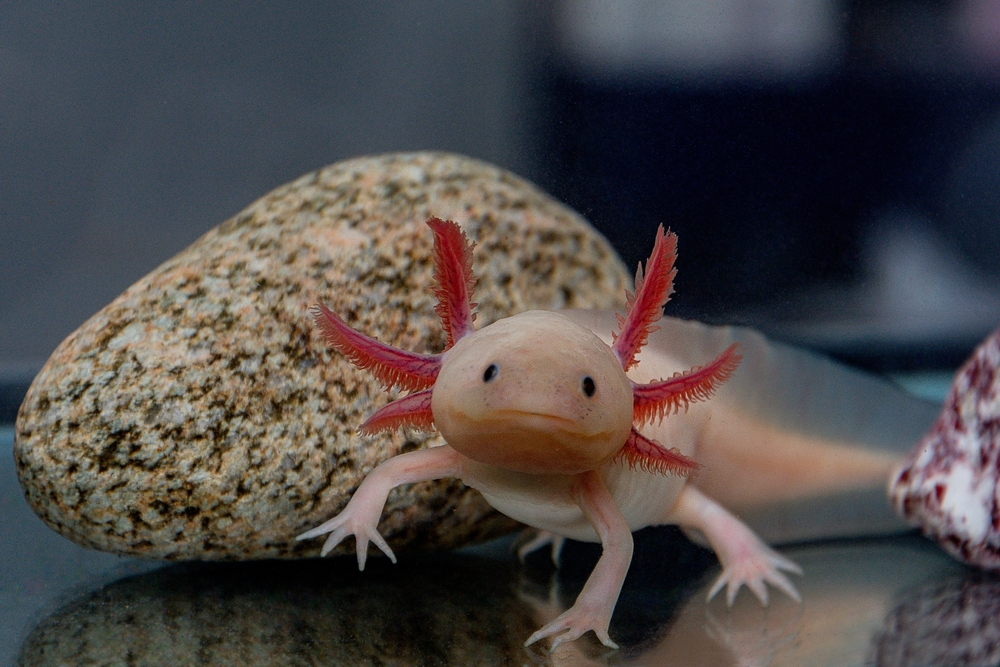Exploring the Depths: 10 Interesting Facts About the Enchanting Axolotl

Welcome to “Exploring the Depths: 10 Interesting Facts About the Enchanting Axolotl,” where we unravel the mysteries of one of nature’s most extraordinary creatures.
The axolotl, a species of salamander native to the freshwater lakes and canals of Xochimilco near Mexico City, has fascinated scientists, nature enthusiasts, and mythology buffs alike.
Unlike most amphibians, the axolotl spends its entire life in water, retaining its larval features into adulthood—a phenomenon known as neoteny.
This unique evolutionary trait, combined with their astonishing ability to regenerate lost body parts, places axolotls at the forefront of scientific research, offering insights into cellular regeneration and evolutionary biology.
Beyond their scientific significance, axolotls hold a revered place in mythology, symbolizing the mysterious and untamed forces of nature.
Join us as we dive into ten captivating facts about these enchanting creatures, revealing their importance in our world’s ecological, scientific, and cultural tapestry.
1. Unique Habitat
The axolotl boasts an origin and a current habitat that is as unique and intriguing as its biological makeup. Native exclusively to the freshwater lakes and canals of Xochimilco, a UNESCO World Heritage site near Mexico City, these creatures thrive in environments that many other species might find challenging.
The conditions of their natural habitat are characterized by cool water temperatures ranging from 14 to 20 degrees Celsius (57 to 68 degrees Fahrenheit) and a generous amount of aquatic vegetation, which provides both food and cover.
This delicate ecosystem is essential for their survival, offering the perfect balance of resources needed for axolotls to live and breed.
Unfortunately, the rapid urbanization and pollution that have besieged Xochimilco pose significant threats to their natural environment, making the conservation of these habitats as critical as it is challenging.
2. Fascinating Biology
The axolotl’s biology is as fascinating as its mythical reputation, marked by intriguing physical characteristics and extraordinary regeneration abilities. With a look that captures the imagination, axolotls can grow up to 30cm in length, showcasing a variety of colors from wild-type greenish-brown to albinos, leucistics, and even striking melanoids.
Beyond their appearance, what sets axolotls apart in the animal kingdom is their astonishing regenerative capabilities.
These creatures can fully regenerate lost body parts, including limbs, tails, hearts, and even portions of their brain, without scarring—a feat that remains the envy of scientific and medical communities.
This incredible ability not only highlights the axolotl’s resilience and adaptability but also provides invaluable insights into regenerative medicine, potentially paving the way for groundbreaking advancements in human health.
3. Eternal Youth
The allure of eternal youth, a concept often explored in tales and mythology, finds a tangible example in the biological phenomenon of neoteny observed in axolotls.
Unlike other amphibians that undergo metamorphosis to transition from water-breathing larvae to air-breathing adults, axolotls retain their larval features throughout their lives. This means they continue to sport their gills, allowing them to live underwater indefinitely.
This fascinating aspect of their biology starkly contrasts with the lifecycle of other amphibians, like frogs or salamanders, which usually lose their larval characteristics as they mature.
The axolotl’s perpetual youth is not just an astounding evolutionary trait but also a window into understanding the mechanisms of growth and development in vertebrates.
By studying these remarkable creatures, scientists hope to uncover the genetic underpinnings of neoteny, potentially offering clues to the aging process in other species, including humans.
4. A Critically Endangered Species
The axolotl’s title as a critically endangered species underscores the urgent need for conservation efforts to preserve this fascinating creature.
The primary causes of their endangerment stem from habitat destruction due to urban expansion, water pollution, and the introduction of invasive species, which compete for resources and disrupt the delicate ecological balance of the axolotl’s natural environment.
Conservation efforts have been implemented, including captive breeding programs, habitat restoration projects, and legal protections to safeguard their remaining natural habitats.
Environmental organizations and researchers are tirelessly working to increase public awareness and promote sustainable practices that can help alleviate the threats facing axolotls.
These concerted efforts aim not only to save the axolotl from extinction but also to preserve the rich biodiversity of the ecosystems they inhabit, reminding us of the interconnectedness of all life forms on our planet.
5. A Palette of Colors
Amidst the compelling characteristics of axolotls, their palette of colors stands out as another fascinating aspect of their biology.
These creatures exhibit a remarkable spectrum of color variations, from the wild-type greenish-brown, which offers camouflage in their natural habitat, to strikingly pure white albinos, mysterious blacks of melanoids, and the ethereal pinkish hue of leucistics.
These color variations are more than just aesthetically pleasing; they’re a result of specific genetic traits.
Albinism, for example, is due to a genetic mutation that inhibits the production of melanin, the pigment responsible for dark colors, resulting in their translucent and pink appearance. Melanoids, on the other hand, present an overload of melanin, offering a deep, uniform black color.
These variations are not merely cosmetic; they play a role in the axolotl’s survival and have become a significant point of interest for genetic research.
By understanding the genetic mechanisms behind these color variances, scientists can gain insights into genetic mutations, the function of pigments in living organisms, and the broader implications of these factors on biodiversity and conservation efforts.
6. The Axolotl’s Diet
The axolotl’s diet reflects its adaptability and carnivorous nature, varying significantly between wild environments and captivity.
In the wild, axolotls engage in a diet that primarily consists of small prey, including worms, insect larvae, crustaceans, and some small fish, leveraging their natural habitat’s biodiversity to thrive. This diet is opportunistic, relying on the abundance and variety of prey available in their freshwater lake and canal ecosystems.
In contrast, the diet of axolotls in captivity is tailored for convenience and nutritional balance, often consisting of commercially available fish pellets, lean meats like liver or beef heart, and live food such as bloodworms, brine shrimp, or earthworms to mimic their natural feeding habits.
The transition from a natural to a controlled diet in captivity highlights the importance of ensuring that axolotls receive all necessary nutrients for health and longevity, making the task of feeding them both a science and an art, which fascinates both pet owners and researchers alike.
7. Reproduction and Lifecycle
The fascinating world of axolotls extends into their unique breeding habits and lifecycle, a subject that captivates scientists and enthusiasts alike. Axolotls reach sexual maturity around 18 to 24 months of age, with their breeding season typically occurring in the spring.
In a process that seems orchestrated by nature’s subtle cues, male axolotls engage in a courtship dance to attract females, depositing spermatophores that the female then collects to fertilize her eggs. A single female can lay between 100 to 1,000 eggs, which she carefully attaches to plants or other substrates in the water.
These eggs encapsulated in a jelly-like substance, hatch in about two to three weeks, unveiling tiny axolotl larvae equipped with external gills for breathing.
The juvenile axolotls undergo a series of morphological changes as they grow, but unlike other amphibians, they astonishingly retain their larval features into adulthood, embodied by their iconic gills and aquatic lifestyle.
This perpetual state of larval features, a phenomenon known as neoteny, means axolotls remain in water their entire lives, bypassing the terrestrial stage entirely.
Their lifecycle, from egg to adult, not only showcases the axolotl’s extraordinary adaptation to its environment but also offers invaluable insights into the evolutionary mechanisms that drive such unique developmental pathways.
8. Axolotls and Medical Research
The mystique surrounding axolotls extends far beyond their appealing aesthetics and captivating behavior; these creatures are at the forefront of significant breakthroughs in medical research, particularly in the field of regenerative medicine.
Scientists are intrigued by axolotls’ unparalleled ability to regenerate lost or damaged body parts, including limbs, heart tissue, and even parts of their brain, a feat that remains a distant dream in human medicine.
Ongoing scientific studies endeavor to unlock the genetic code that enables such extraordinary regenerative processes, with the hope of applying these insights to human health.
By understanding the mechanisms behind axolotls’ regrowth capabilities, researchers aim to pioneer novel treatments that could one day facilitate the regeneration of human tissues and organs.
This promising research not only highlights the axolotl’s invaluable contribution to science but also underscores the importance of preserving these remarkable amphibians, as their very existence could hold the keys to groundbreaking medical advancements.
9. Keeping Axolotls as Pets
Keeping axolotls as pets, while rewarding, encompasses a responsibility to meet their specific care requirements and adhere to legal considerations that vary by jurisdiction. Basic care for axolotls involves maintaining a tank environment that closely mimics their natural habitat – cool, clean water is crucial as these amphibians are sensitive to temperature changes and pollutants.
A filtration system that doesn’t create strong currents, a diet comprising of nutrient-rich pellets, live food like earthworms or bloodworms, and occasional treats can ensure your axolotl remains healthy and vibrant.
Additionally, providing hiding spots and a dark substrate will mimic the murky bottoms of their natural waters, offering comfort and security. Legal considerations are equally important; in some countries or regions, keeping axolotls as pets requires specific permits due to their status as critically endangered species.
It’s imperative to research and comply with local wildlife conservation laws to ensure that your interest in axolotls as pets contributes positively to the efforts of their preservation rather than undermining it.
By prioritizing the well-being of these fascinating creatures through proper care and legal adherence, enthusiasts can enjoy the unique experience of having an axolotl as a pet while supporting conservation efforts.
10. Cultural Significance
The cultural significance of axolotls spans centuries, deeply rooted in mythology and popular culture. These enigmatic creatures hold a place of reverence within Aztec mythology, where they are linked to the god Xolotl, who was believed to have transformed into an axolotl to escape exile.
This mythological association imbues axolotls with a sense of divine escape and transformation, resonating with themes of survival and adaptability.
Beyond their mythological roots, axolotls have captivated the modern imagination, making appearances in various forms of media, from books and movies to video games, where they often symbolize mysteriousness and exoticism.
Their unique appearance and regenerative abilities have inspired characters and stories that explore themes of renewal and resilience, making the axolotl not just a subject of scientific fascination but also a cultural icon that continues to inspire and intrigue.
Conclusion
In the exploration of the enchanting world of axolotls, we’ve traversed through a realm that intertwines the mystical and the scientific, unveiling ten remarkable facts that highlight why these creatures captivate our imaginations and demand our respect.
From their striking ability to regenerate lost body parts to their intriguing lifecycle and cultural significance, axolotls stand as a testament to nature’s marvels.
Beyond their fascinating biological and cultural aspects, the axolotl reminds us of the delicate balance within ecosystems and the critical importance of preserving their species and natural habitats.
These creatures are not just subjects of admiration for their unique features but also harbingers of broader environmental messages, emphasizing the necessity of conservation efforts.
The survival of axolotls is intricately linked to the health of their environments, underscoring the interdependence of life and the urgent call to protect vulnerable species from the brink of extinction.
By cherishing and safeguarding axolotls, we are indeed preserving a part of the world’s natural heritage, a legacy of wonder and scientific potential that could unravel mysteries in medicine and beyond.
Thus, as we conclude this exploration, it becomes clear that our fascination with axolotls is not just about their allure but also about the critical role they play in inspiring conservation efforts, advancing scientific research, and enriching our cultural tapestry.
In closing our exploration of the captivating axolotl, we extend a heartfelt invitation to our readers to not only marvel at these creatures but to actively participate in their preservation. The plight of the axolotl, mirroring that of countless other endangered species, calls for collective action.
You can contribute to conservation efforts by supporting habitat preservation initiatives, adopting sustainable practices that reduce pollution, and engaging with organizations dedicated to wildlife conservation.
Furthermore, we encourage you to deepen your understanding of axolotls and other endangered species. By educating yourselves and others, you help raise awareness about the importance of biodiversity and the urgent need to protect our planet’s fragile ecosystems.
Whether it’s through reading, attending workshops, or even visiting local conservation sites, every effort to understand more about these remarkable creatures and their roles in our world aids in their survival.
Your curiosity has the power to make a difference. Together, by fostering a culture of learning and action, we can help ensure that the enchanting axolotl, along with many other species on the brink of extinction, continues to thrive for generations to come. Join us in this critical mission—explore, learn, and act for the preservation of our planet’s incredible biodiversity.




